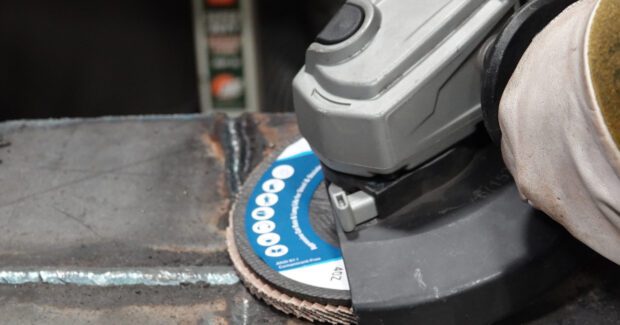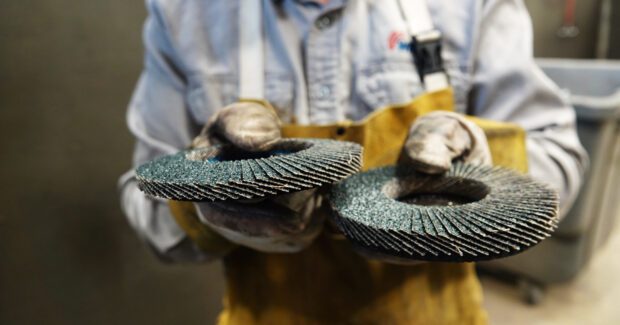Benefits of Using a 5- or 6-Inch Grinding Wheel or Flap Disc
More fabricators are using larger-diameter grinding wheels and flap discs for their grinding, material removal, and blending applications instead of 4.5-inch options — and with good reason.
Posted: January 29, 2020
SURFACE CONDITIONING
Using a 5- or 6-inch grinding wheel or flap disc can significantly reduce grinding and blending time because the operator can cover more area faster. A more abrasive product coming into contact with the base material means faster work. And, because large-diameter grinding wheels contain more abrasive material, they typically provide longer product life and require less frequent changeover.
In addition to productivity and performance benefits, 5- and 6-inch grinders have gotten lighter and more cost-effective in recent years. The reduced weight makes them comparable to the weight of a 4.5-inch grinder, whereas previously they were closer to the heavier 7- and 9-inch grinders. Due to that added weight, some operators may have shied away from using a 6-inch grinder, which could take a toll on the body over a day’s work.
With 6-inch grinder weight — and cost — more comparable to 4.5-inch options, fabricators can take advantage of the benefits of larger-diameter products in many applications.
What Size Grinder for the Job?
Expanded reach capabilities have made 5- and 6-inch grinding tools popular in construction applications for a long time. As large-diameter tools have become lighter and more manageable for operators, their use is growing in other applications as well.
The greater reach and abrasive contact patch of large-diameter products can deliver performance and productivity benefits in pressure vessel, pipeline, and shipbuilding applications as well as general metal fabrication. Large-diameter products have increased reach, allowing better access and contact in corners, gaps and overhangs.
A 6-inch flap disc can also offer benefits from a blending and finishing perspective, since a larger product requires fewer strokes to blend seams and creates a smoother finish. Having a larger amount of abrasive material contact the workpiece — spread over a wider area — also helps minimize heat dissipation, discoloration, and potential gouging.
Keep in mind that a large-diameter product isn’t a one-size-fits-all solution for every application. Small-diameter products may still be the better option when working with ornamental fabrication or in smaller, tighter areas because a larger tool can be more difficult to adjust and manage in tight areas.
Increase Efficiency Up to 50%
Using large-diameter grinding wheels and flap discs can pay off in several ways.
The initial cost difference between a 4.5-inch grinder and a 6-inch grinder is much less than it was just a few years ago. Even though the grinders are a bit more expensive, it’s possible to save money due to the extended life of the disc, decrease in changeover time, and ability to cover more material faster.
Hands-on testing of a 4.5-inch product compared to an equivalent 6-inch grinding wheel or flap disc supports this return on investment.
Both products were used to grind basic weld seams. The 6-inch product with the same material configuration was 25% to 50% faster than the 4.5-inch product in completing the work on the same size weld. This range depends on the type of abrasive grain used. Individual results will vary based on many factors including, but not limited to, tool power, abrasive grain, operator skill, the material being ground, and application.
And these productivity gains only reflect actual time spent on the weld. Savings can increase significantly if you take into account the longer product life, resulting in savings from using fewer products and reduced time spent on changeovers.
Large-diameter grinding products can also help reduce forearm fatigue. Many 6-inch grinders provide increased power compared to a 4.5-inch grinder, which means the operator can get more leverage on the grinder itself. This can help operators feel like the tool is doing more of the work, so they don’t have to push as hard — minimizing the amount of heat introduced into the work piece and maximizing the life of the abrasive.
Type 27 vs. Type 29
Simply switching to a 5- or 6-inch flap disc or grinding wheel may not yield the expected performance and productivity results if the operator is using the wrong type of product for the job. There are multiple profile options for flap discs and grinding wheels, and it’s important to understand the differences when choosing which type best suits the application.
Flap discs, for example, are available in type-29 and type-27 profiles. A type-27 flap disc has a flat profile and is designed for lower grinding angles and lighter pressure, typically used in finishing and blending operations. A type-29 flap disc has a slight angle and is designed for high pressure and grinding at steep angles and applications where stock removal is a primary objective.
If a type-27 6-inch flap disc is being used to grind at a steep angle, the operator may only be using 15% to 20% of the abrasive material — possibly even less. In effect, the operator is wasting the rest of the flap disc material that isn’t touching the metal surface. That’s why choosing the right type of disc is important to optimize results.
Benefits of Larger Grinders
There will always be some applications where a smaller grinder is the better option, but large-diameter grinders can offer significant performance and productivity benefits in many fabrication applications. When more abrasive material contacts the workpiece, it can help operators complete the job faster, reduce product changeover, and save money.













